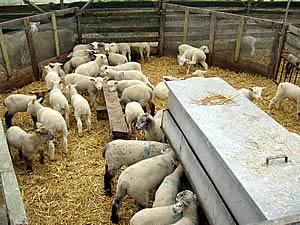16/01/09
Lamb growth rates improved by almost 12% in the first five weeks of life, and weaning weights by 2kg/lamb, as a result of improved selenium status in ewes in late pregnancy and early lactation, according to University College Dublin (UCD) research.
Improved survival rates, growth rates and weaning weights are a consequence of improved selenium status in the ewe, according to the latest research.
 |
The work, which studied the impact of feeding the organic selenium supplement Sel-Plex to ewes during the final seven weeks of pregnancy and 15 weeks into lactation, is consistent with other studies based on supplementation earlier in pregnancy. The results underline the importance of dealing with inherently low levels of this essential trace element in home grown forage and cereals in order to optimise flock performance.
In the UCD study, fifty ewes on ad lib grass silage were randomly allocated to either a treatment or control group 98 days after oestrus-synchronised mating. The treatment group received a concentrate containing selenium as Sel-Plex (0.875mg/kg) initially at 500g/head/day whilst the control group received the same concentrate but with inorganic sodium selenite (0.875mg/kg) as the selenium source. The concentrate feeding rate was increased to 700g/head/day from 134 days post-mating until 24 hours after lambing. Ten ewes from both the treatment and control groups were kept indoors for ten further days and milk from these ewes was analysed for selenium content.
Selenium supplementation with Sel-Plex was shown to increase the level of selenium in the ewes milk (98µg/l compared with 60µg/l from those on the control ration), and this was then linked to the improved performance. Lambs from the ewes receiving Sel-Plex grew at 326g/day during the first 35 days compared with 292g/day achieved by lambs in the control group. This improved performance was continued through to weaning, where the Sel-Plex group weighed a full 2kg heavier (31.1kg compared with 29.1kg).
As Alltech’s Neil Keane explains, selenium has a key role and enhanced supplementation does help overcome common problems quite demonstratively.
“Selenium is vital to many of the lamb’s natural immune response and disease resistance mechanisms,” he explains. “If the ewe is deficient, lambs won’t receive the necessary levels in the milk and survival rates will be severely affected.
“For example, in the defence against cold, selenium has a vital role in two areas. Firstly, it is required in the mechanism that allows the thyroid gland to stimulate heat generation from brown fat, an attribute that lambs should have from birth to about 3-4 weeks of age. Secondly, selenium is required in the prevention of white muscle disease, a condition that will lead to the lamb’s inability to respond by shivering.
“As seen in this study, the improved selenium status is about more than just survival, as it has a positive effect on the lambs way beyond these early days.
“Ewe selenium status can be improved by feeding the trace element as Sel-Plex, which is a more bioactive form than conventional inorganic supplementation. This UCD work shows that introduction relatively late in pregnancy and into lactation is beneficial, although beginning supplementation earlier is generally recommended.”
 SABRE Project Makes Major Livestock Breeding Progress SABRE Project Makes Major Livestock Breeding Progress
 Downland Launches Premadex Pour-On Endectocide for Cattle Downland Launches Premadex Pour-On Endectocide for Cattle
 Downland Introduce Lamb Force Ewe Milk Replacer Downland Introduce Lamb Force Ewe Milk Replacer
|



